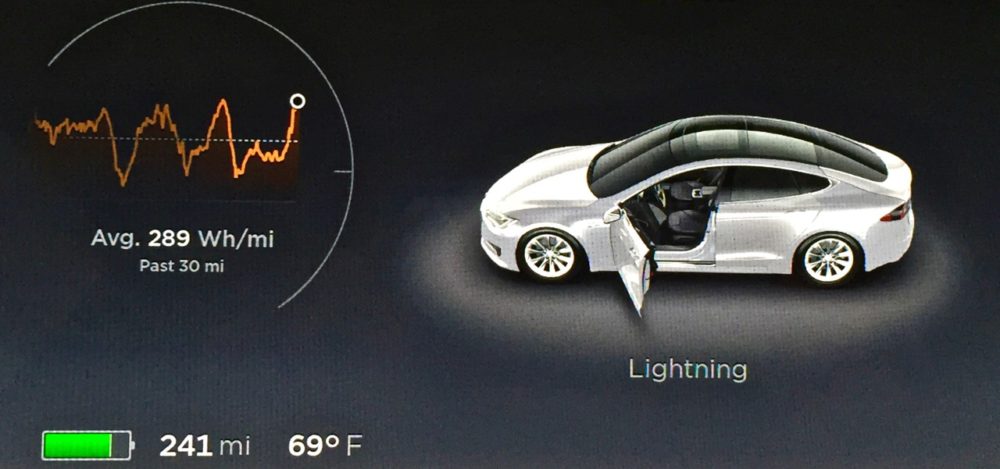For anyone wondering what it’s like to order and wait 10 weeks for a Tesla, I wrote a 3-part series on it. carlhowe.com/blog/getting-t…
Monthly Archives: June 2016
Part 3 of the purchase process: Patience

Every Tesla owner will tell you that the most painful part of the purchase process is waiting for delivery.
For people more used to going to a dealer’s lot and picking out a car, it may seem crazy that Tesla buyers are willing to wait anywhere from 6 to 26 weeks to be able to buy an expensive electric car. While the Tesla factory is presently making 2,000 model S and X cars every week, roughly double of what Tesla achieved in 2015, every Tesla buyer has to wait in the production queue for their car. There are no cars on Tesla lots for you to choose from; everyone has to wait for their new Tesla.
Said another way, despite doing no advertising whatsoever and doubling production capacity each year, Tesla sells every car it can make with no discounts and still maintains a nearly 2 month backlog of orders.
Here’s how my delivery evolved. Because of a pending business trip, I had ordered by car in early April and hoped for delivery in May. My actual timeline was:
- 2016-04-01: Order entered and deposit paid
- 2016-04-04: Order modified from S70D to S90D
- 2016-04-08: Order committed to production queue and VIN number assigned
- 2016-05-24: Production start
- 2016-05-30: Production complete
- 2016-05-31: Car in transit
- 2016-06-07: Car arrived in Dedham
- 2016-06-09: Final payment made
- 2016-06-11: Car delivered and accepted
In summary, my car took 72 days from order confirmed to delivery, or roughly 10 weeks. Once I had a VIN committed, Tesla had given me an estimated delivery date of late May-early June. On production start, that changed to June-early July, but I think Tesla was simply being conservative about how long it would take to batch up my car with others going to the East Coast and actually transport it (it can take 3 weeks, depending on rail and truck schedules).
The mean time between order confirmation and delivery during April through June was only 45 days, so clearly my 72 day production time was a bit of an outlier. I attribute that to the fact that I had bought during a model design change. I originally was scheduled to get a model S version 1, and what I actually received was a version 2. Clearly the production line must have had some slowdowns to accommodate the production changes.
The best thing about the ordering process is that Tesla assigns you your own Web page for your car and updates that regularly. To smooth the delivery process, you upload all your documentation to that page for the delivery specialists to work with, and they in turn provide you with instruction manuals, videos, and updates on the delivery process. While it was a very long 10 week process, I felt like Tesla kept me informed and made the process as painless and efficient as possible. I used that information to have substantive conversations with the delivery specialists along the way, and when delivery day rolled around, I felt like I was ready. For an expensive car ordered over the Internet, it’s probably the most relaxing experience I can imagine.
The bottom line: Just like Heinz Ketchup, ordering a Tesla requires patience, but it’s worth the wait.
Part 2 of the purchase process: Decisions, decisions
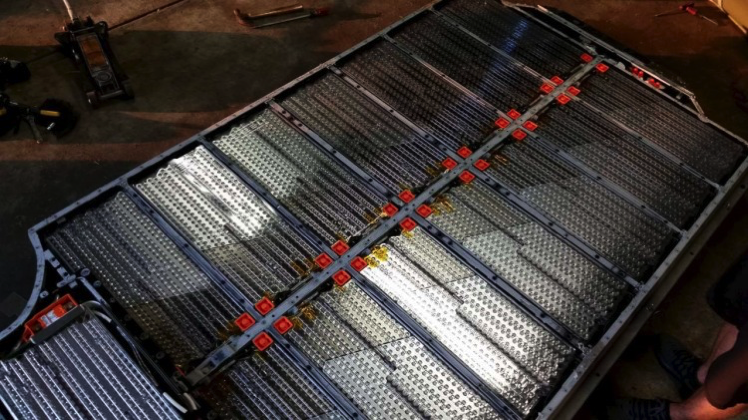
Ordering my car on April 1 was just the beginning of my Tesla odyssey.
When you order a Tesla, you automatically get 7 days during which you can change your order without penalty. And over the weekend of April 1, I began to wonder if I’d ordered the right car.
What started me having second thoughts was that my Tesla salesperson notified me that a silver fleet vehicle (I was insisting on the metallic silver paint, which is rather uncommon for Teslas) car that was configured almost identically to what I had ordered had become available. There were, however, a few differences:
- It had 2,049 miles on the odometer already. The car had been delivered on December 31, 1995 to Las Vegas for use in Tesla’s fleet of demos and loaners, so it already had some miles on it.
- It would come with a $6,800 discount. Because it was a fleet vehicle, it would be sold as new, but would be discounted off the list price.
- It had a 90 kWh battery and a panoramic roof option. I had ordered a 70 kWh battery without the fancy glass roof, but I could get roughly 28% more range by buying this fleet vehicle and paying a bit more (well, really about $13,000) than what I ordered. Given that the value of an electric car is in many ways tied to its range, this was tempting even though it was more.
- It was available immediately. If I were to buy this vehicle, I’d only have to wait for it to be shipped to me from Las Vegas. Compared with the 6 to 10 week waiting period for a custom build, this was also tempting.
I asked my salesperson if he could hold the car over the weekend while I thought about it. He said he couldn’t; because of their discounts, fleet vehicles rarely were available for more than a day or two. So I said I’d hold off, but ended up calling back the next day and asking if the fleet vehicle was still available. As my salesperson had noted, this was too good a deal to last long–it had been sold within hours of being listed. So I was back to my custom order.
There was only one problem: the opportunity to buy a big battery car had now whetted my appetite for a max-range vehicle. The S70D was rated at around 240 miles range while the S90D was 293. That extra 50 miles seemed like a nice margin to have because:
- Most of our foreseeable trips were in the 250 mile range. When we looked at our travel patterns over the past few years, we’ve been driving to colleges such as the Culinary Institute of America (200 miles), The University of Vermont (240 miles), and the University of Maine (256 miles). With a 250 mile battery, those will all demand at least one supercharger stop. With a 290 mile battery, one stop would be enough, and if we had to, we could hypermile the entire trip without a stop.
- You never drive in optimal conditions. Just as you rarely get the advertised fuel efficiency in an internal combustion engine car, similarly, you rarely get the full range out of your battery either. Once again, the big battery would just give us more comfort driving in winter or during bad weather when we really don’t want to get out of the car.
- We’ll mostly be using 60% of the battery’s capacity. You get the longest life out of an electric car battery if you run it primarily between 80% and 20% charge. That means that if we have to drive the car for an unanticipated trip, the expected range for the S70D will be more like 144 miles for the S70D and 176 miles for the S90D. Admittedly, we still would have 50 to 60 miles in reserve in both cases, but it seemed more prudent to have our everyday range be closer to 200 miles than 150.
- A big battery charges faster. This was a little non-intuitive, but it makes sense. Charging at a supercharger on the road happens fastest up to the 80% mark. After that point, the charging rate decreases rapidly to avoid overcharging the battery. What this means is that when we are traveling roughly 200 miles between superchargers (they are often closer together than that), we’d be spending longer at the supercharger stations with the small battery than with the big.
- The battery will degrade with time. The small battery will be just fine the first year we own the car, but we know that batteries degrade over time. If I assume that the battery will degrade about 3% a year (I made up that number), then I’ll have only 86% of the original battery capacity in 5 years. Given that I kept my last car for 15 years, a bigger battery to start will give me more lifetime to the car without being range constrained.
Ok, so maybe I overanalyzed this a bit. But at the end of the day, I decided that if I was going to invest in going electric, I should commit fully to having the best electric experience I could.
As it turned out, Elon Musk confirmed that we’d made the right decision not to get the fleet vehicle. Along with the Model 3 announcement on March 31, Musk announced that the Model S was getting a minor facelift, some new features had become standard, and the prices were going to increase slightly. Anyone with a model S already on order would get these new features at no extra cost. And I had an order in the system.
After all my battery analysis over the weekend, I changed my order to an S90D on Monday, and by that Friday, my order was committed to the factory order and provisioning queue. Now the waiting really began.
Looking forward to Think Big’s Douglas Moore’s tal…
Status
Looking forward to Think Big’s Douglas Moore’s talk today about Big Data use cases at TDWI Boston today.
Part 1 of the purchase process: Getting to yes on a model S

Tesla really does do things differently.
On March 31, 2016 my son Robert and I both went to the Natick Mall Tesla store to stand in line and get early reservations for Tesla Model 3s, the roughly $35,000 models that will start shipping in late 2017. I reserved one for my wife; Robert reserved one for himself.
As I admired the roughly 250 people standing in line to pay $1,000 for a car they’ve never even seen, I made up my mind that I should try to get a model S to beat the rush of new Tesla owners. That has turned out to be a prudent decision: roughly 400,000 people have put deposits down on model 3s, so it will be a while before all those orders are filled once it begins production. That won’t happen until at least 2017, but it suggests the production line is going to be very busy at the end of next year.
I had taken two test drives of a Model S previously at the Natick Tesla store, one on October 18, 2013, and another on August 29, 2015. That last appointment took roughly 6 weeks to set up; Tesla test drives are very popular here in Massachusetts. At the last test drive, I’d had both my wife and Robert drive the car, and they both thought it was both fun to drive and would be a good next car. So with family approvals in place, now all that I needed to do was put in an order.
While you probably could order a car in the store, the reality is that any Tesla order actually gets constructed on the web site. I created an account and configured a S70D to my liking. For those not familiar with Tesla nomenclature, the S means Model S (and not an insane or ludicrous mode performance P version), the 70 means a 70 kilowatt-hour (kWh) battery, and the D means dual-motor/all-wheel drive. I figured I didn’t need the biggest battery because we have a lot of superchargers here in New England, so I went with the small one, which was advertised to give me about 230 miles of range.
The actual configuration above didn’t take long; I had custom built the same configuration about 50 times before. What changed this time was that I hit the big red capitalized “PLACE ORDER” button:

That action started my more than 2-month quest to becoming a Tesla owner. I’ll talk more about what happened along the way in my next post.
My Tesla goes to the gas station
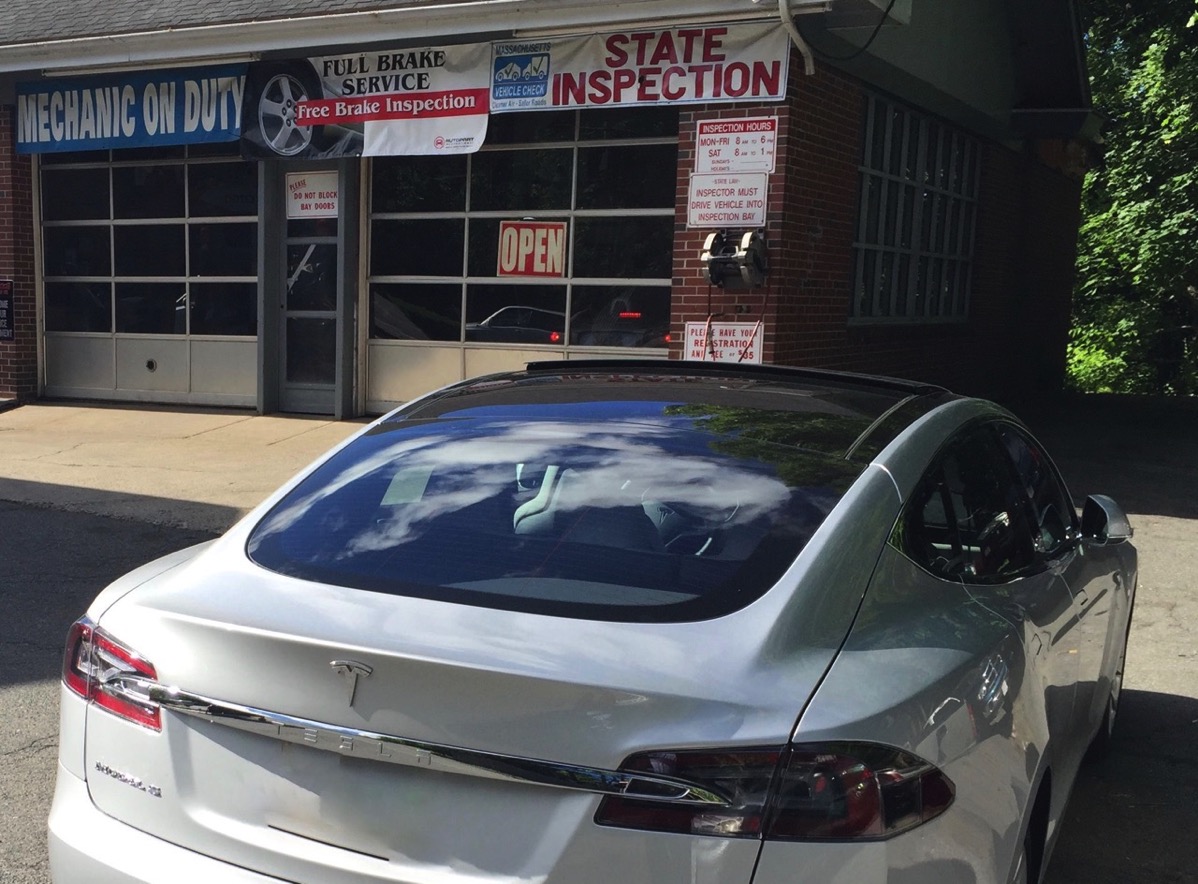
I received my Massachusetts registration last night by email, so all I had to do today to be fully legal was get the car inspected. As I noted in a previous post, one of Tesla’s unique challenges in Massachusetts is that it is not allowed to inspect its cars like a normal car dealership. Why? Well, Tesla doesn’t have a MA-certified emissions exhaust system in its service centers, and that’s a requirement for an inspection station. The fact that all of Tesla’s cars are zero emissions doesn’t seem to eliminate the requirement, and it’s a fairly expensive system to install to never use it. Ergo, my Tesla had to visit my local gas station, where I will never buy gasoline, to make my car legal.
Oh, and in case anyone is wondering, I do have MA plates on the car, but I’ve blurred them out for privacy reasons. They aren’t actually the final plates for the car anyway; I have ham radio operator plates being made by the RMV, but they haven’t arrived yet.
Charge it!
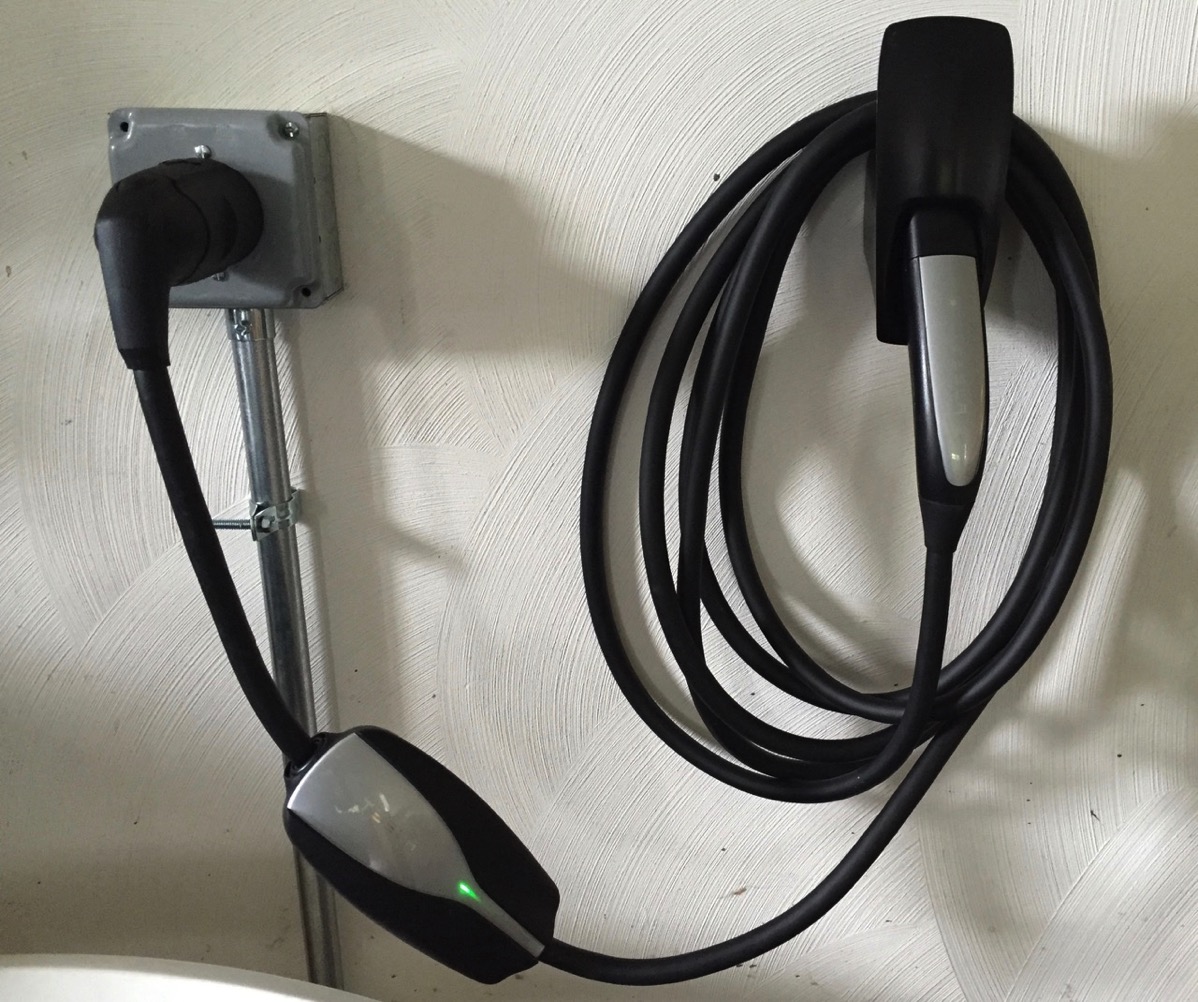
Odometer: 101 miles
Another frequently asked question about our car is “How do you charge it? Do you just plug it into the wall?” The answer to that is yes, but you really need the right plugs on your wall.
I brought in an electrician as soon as we ordered our Tesla to prepare our garage for electric cars. Here’s how we approached the problem:
- We upgraded our main power panel. We put in solar cells as the first step in our going green initiative, and as a result of that and other home upgrade initiatives, our main 200A breaker panel was one breaker short of what we needed to install our garage outlets. Given that the main breaker panel was more than 20 years old, we bit the bullet and had the electrician install a modern one that will give us a lot more room for more circuits.
- We installed two new 240 volt, 50 amp NEMA 14-50 circuits (see right).
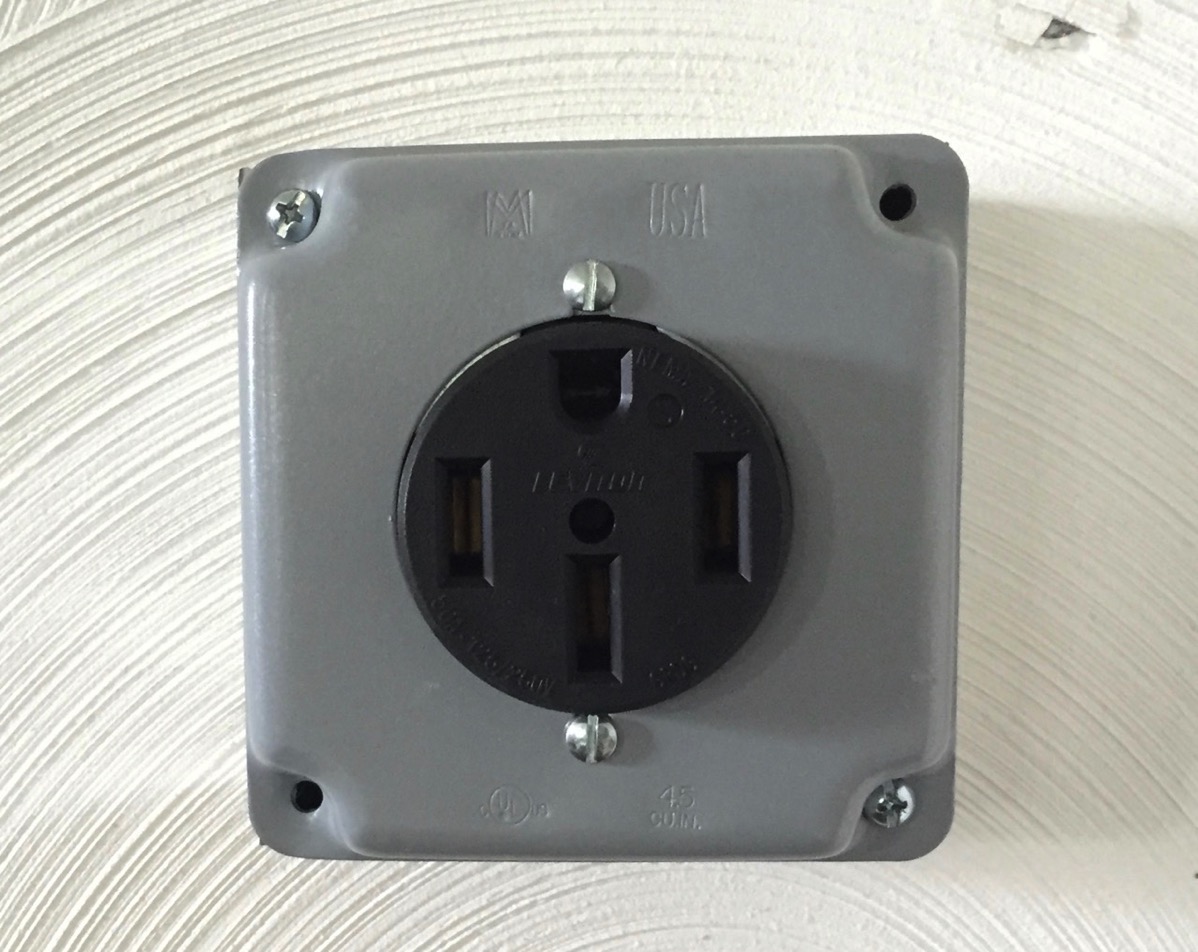
Once the new panel was in, the electrician installed two 50 amp breakers in the subpanel we had installed for our air conditioning system. Those NEMA 14-50 plugs allow us to charge our Tesla at 40 amps, which adds range at about 29 miles per hour. Said another way, these plugs will fill the battery from empty in around 10 hours. We decided to go with NEMA 14-50 instead of a Tesla Wall-Mounted Charger as a form of future proofing the installation. While we love our Tesla, it’s conceivable we or our guests might want to charge other types of electric cars that don’t use a Tesla connector. With standard connectors in the garage, we retain flexibility. - We bought a second Tesla Mobile Connector to charge the car. The car comes with a Mobile Connector bundle that allows the car to charge from 110 volt (NEMA 5-15), 240 volt (NEMA 14-50), and J1772-compatible power sources. We leave that one in the car, and we have a dedicated second connector that hangs on our wall as shown in the photo at the top of the post. That way we never forget to pack the charging cable, and we can organize the cables a bit more tidily at home (although the photo shows I’m not yet that good at that).
Important installation tip: Some electricians will orient the NEMA 14-50 connector with the square ground lug at the bottom, just as it would be on a 110-volt outlet. Don’t let them do that; if you do, your Mobile Connector will be upside down. You want it the way it’s shown in the photo above.

Actually charging the car is a dead simple process once you learn it:
- Double click the button on the mobile connector cable. That will tell the Tesla to open and light up its charging port. It should glow white at this point.
- Insert the connector firmly into the charging port. If you plug it all the way in, the car will begin charging and the port will pulse green to indicate it is charging. Fast pulsing indicates fast charging, but it will slow as the battery approaches “full”.
- When the port stops pulsing green, or your mobile app or touchscreen notify you that charging is done, click the connector button to unlock and unplug the car. The charging connector is locked into the port while charging, so the button push requests permission to unplug. When the port turns white, you can unplug the connector.
If we arrived home with an empty battery, it would take about 10 hours to charge the battery to full. However, we plan to never arrive home empty, and we almost never charge the battery to full unless we’re going on a trip. My charging model is to model 80% of battery capacity as “full” and 20% of battery capacity as “empty.” Only charging to 80% routinely extends the life of the battery, while assuming 20% charge as empty provides lots of range (about 60 miles) to find somewhere to charge.
The prime directive of battery management is that you’d rather be too full than too empty. Running out of battery charge is much much worse than running out of gas; it will likely involve a flat-bed truck to tow the car and could damage the battery itself. You should view running out of charge in a Tesla with the same concern you’d have about running out of gas in an airplane: it’s a very bad thing.
Come on a journey with me. I’ve begun a blog about…
Status
Come on a journey with me. I’ve begun a blog about the multi-year process of becoming an all-electric car family. carlhowe.com/blog/first-pos…
Monday update: First over the air update
Odometer: 101 miles
We did a bit of driving yesterday, and my two sons tried driving the car. They are much more cautious with the car than I am, which just proves how intelligent and mature they both are.
We received a Summon over-the-air update overnight, which appears to help with the car going in and out of our garage. I have now customized the autoparking function so that it doesn’t complain until objects get within 8 inches of the car. With that new setting, I’ve been able to have the car drive itself out of the garage and then repark itself back in the garage from that position. However, when I simply randomly parked the car in the driveway and told it to autopark, it thought about it for a bit, and then aborted. I interpreted that as the car saying, “No, that’s too risky. Just no.”
This car is as smart as my kids.
D-Day: the Lightning has landed
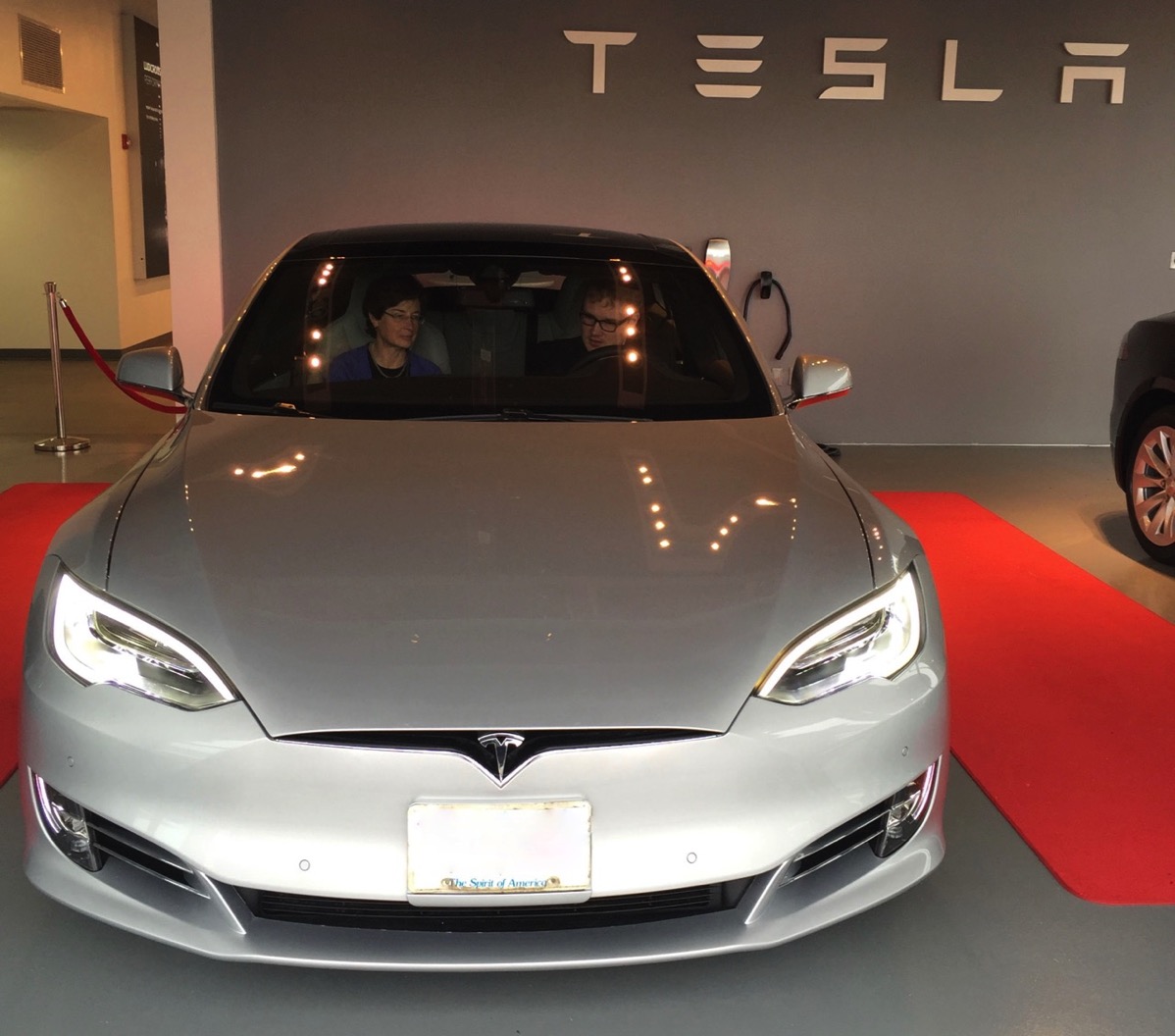
Odometer: 39 miles
We’ve taken delivery of the car and gotten it home. Our initial reactions so far are pretty predictable if you have read Tesla reviews before:
- The quiet of electric drive is fabulous. ‘Nuff said.
- Acceleration is incredible and fun. I don’t have either Insane or Ludicrous mode on my car, and it is still incredibly fast. The spec is 0-60 in 4.2 seconds, but it certainly blows me away. The acceleration is strong enough that it makes your stomach muscles tense up to take the G forces. Oh, and top speed is 155 mph, so it’s really easy to blow past the speed limit when you are having fun; cruise control and autopilot are a must just to avoid tickets in this car; one slip and you can be doing 90 before you realize it.
- Autopilot really works. We used it in I95 on the way home, and it was flawless, even on Massachusetts roads with worn lines.
Here are some of the surprises we experienced during the delivery because Telsa does things differently from other car companies:
- I have no proof I own the car yet. Because I did a trade-in and transferred my plates, I have to wait for an email with my registration. Further, my purchase documents also have to be uploaded to my “My Tesla” site, so I don’t have those either. I’m really hoping I don’t expect any problems, but being stopped would be awkward without a registration.
- I don’t have an inspection sticker. Tesla can’t inspect cars in Massachusetts because its service centers don’t have MA-certified systems for getting rid of car exhaust; that’s a requirement for MA inspection centers. Because I picked up my car on a Saturday, all the inspection centers nearby were closed, so I’ll have to do this myself within the next 10 days.
- The car really doesn’t like my garage. We measured our garage to make sure the Tesla would fit before we bought it. The opening is 92 inches wide, and the car is 86 (77 with the mirrors folded), so the car definitely fits. However, the parking and object awareness sensors get very vocal when anything is within 10 or 15 inches of the car, to the point where it beeps a “Stop!” message when we actually enter the garage. This means that we can’t use the “Summon” feature presently to get the car in and out of the garage. It also means I’ll spend the next many years worrying that I’m going to put a crease in one of my doors or knock off one of my mirrors.
I’ll write more when I’ve taken more trips, but despite all the surprises, my first impression is that the car is worth every penny of its price.
